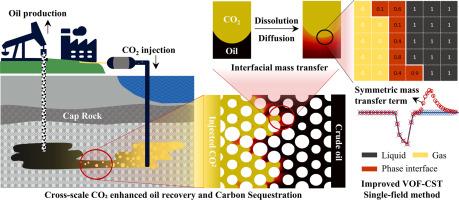Improved single-field VOF method for interfacial mass transfer modeling: Application to CO₂-EOR and carbon sequestration in hydrocarbon reservoirs
IF 5.8
2区 工程技术
Q1 ENGINEERING, MECHANICAL
International Journal of Heat and Mass Transfer
Pub Date : 2025-09-17
DOI:10.1016/j.ijheatmasstransfer.2025.127807
引用次数: 0
Abstract
In enhanced oil recovery and carbon sequestration processes, interfacial mass transfer involved in CO2 displacement plays a critical role. However, accurately characterizing and simulating such interfacial phenomena remains challenging due to the complex coupling between two-phase flow dynamics and phase behavior caused by gas component transport. This study introduces an improved single-field pore scale approach within the VOF-CST framework to model species dissolution and diffusion in CO2-oil two-phase flow. The presented method couples interfacial mass transfer through a source term in the governing equations and introduces an additional symmetric term to control the effective interface movement. The approach is validated by comparing the results to the analytical solution for pure gas dissolution in an immiscible gas-solvent system in a one-dimensional tube. The first application case explores oil swelling during static diffusion in a micro PVT tube, demonstrating great agreement with the experimental results. Secondly, the formation and remobilization of dead-end oil clusters are considered, providing insights into CO2-EOR mechanisms during cyclic CO2 injection. Finally, we simulate CO₂ injection in a complex 2D porous model. The fluid distribution evolution and effective mass exchange coefficients were examined and calculated. Results show that oil mobilization is primarily driven by drainage mechanisms, with significant flow diversion effect observed after breakthrough. This work presents a robust computational framework for investigating interface-dominated multiphase transport phenomena, with direct applications to enhanced oil recovery and geological carbon storage.

改进的单场VOF界面传质建模方法:在油藏CO₂-EOR和固碳中的应用
在提高采收率和固碳过程中,参与CO2置换的界面传质起着至关重要的作用。然而,由于气体组分输运引起的两相流动动力学和相行为之间的复杂耦合,准确表征和模拟这种界面现象仍然具有挑战性。本研究在VOF-CST框架下引入了一种改进的单场孔隙尺度方法来模拟co2 -油两相流中物质的溶解和扩散。该方法通过控制方程中的源项耦合界面传质,并引入一个额外的对称项来控制有效界面运动。通过将结果与一维管内不混相气-溶剂体系中纯气体溶解的解析解进行比较,验证了该方法的有效性。第一个应用案例研究了微PVT管内静态扩散过程中油的膨胀,与实验结果非常吻合。其次,考虑了终端油簇的形成和再活化,为循环注入二氧化碳过程中的CO2- eor机制提供了见解。最后,我们模拟了一个复杂的二维多孔模型中的二氧化碳注入。对流体分布演化和有效质量交换系数进行了检验和计算。结果表明:油层运移主要受排水机制驱动,突破后具有明显的导流作用;这项工作为研究界面主导的多相输运现象提供了一个强大的计算框架,并直接应用于提高石油采收率和地质碳储存。
本文章由计算机程序翻译,如有差异,请以英文原文为准。
求助全文
约1分钟内获得全文
求助全文
来源期刊
CiteScore
10.30
自引率
13.50%
发文量
1319
审稿时长
41 days
期刊介绍:
International Journal of Heat and Mass Transfer is the vehicle for the exchange of basic ideas in heat and mass transfer between research workers and engineers throughout the world. It focuses on both analytical and experimental research, with an emphasis on contributions which increase the basic understanding of transfer processes and their application to engineering problems.
Topics include:
-New methods of measuring and/or correlating transport-property data
-Energy engineering
-Environmental applications of heat and/or mass transfer

 求助内容:
求助内容: 应助结果提醒方式:
应助结果提醒方式:


